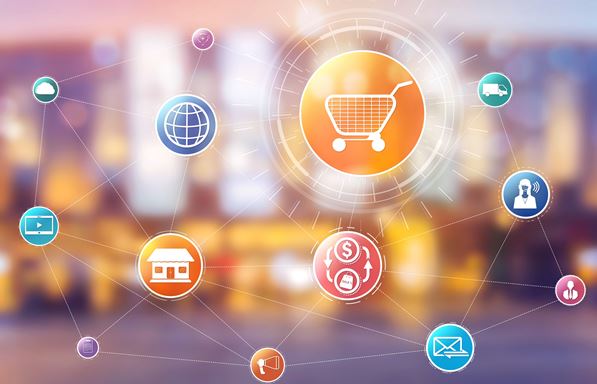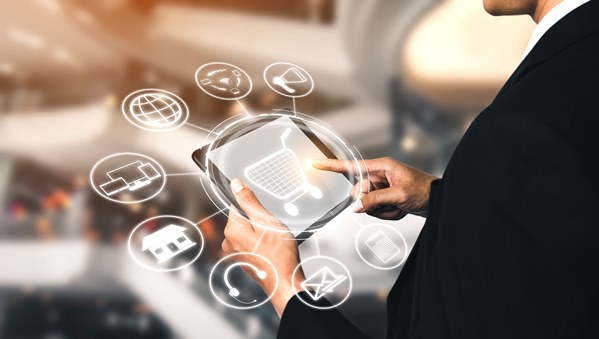
Nowadays, it is a standard practice for businesses to have multiple channels for interacting with customers. In this article, Yasar Jameel takes an in-depth look at omnichannel customer service.
Connecting all the touchpoints and building an omnichannel customer experience can enhance your customer’s interaction with your company. In turn, it can help in boosting sales, drive customer retention and assist your customer support team. But, before we delve deeper, let’s understand what an omnichannel experience is and why it is essential.
What Is Omnichannel Customer Experience?
An omnichannel customer experience comprises unique touchpoints on several marketing channels, such as website, physical store, social media, etc. Omnichannel in itself means a unified customer experience through multiple channels, irrespective of where the customer exits and picks up again.
Using an omnichannel approach helps eliminate gaps in customer service and enhances the quality of the service offered. In addition, unlike traditional or multichannel experience, it ensures higher customer satisfaction. Therefore, it is regarded as the new prescribed benchmark for a premier customer experience.
The customer experience of an omnichannel customer service strategy differs from the single-channel one a lot, and they significantly impact businesses. For example, research conducted by Aberdeen Group reveals that companies with robust omnichannel strategies had a customer retention rate of 89% compared to 33% of organizations with no such plan.
Omnichannel customer engagement varies from the traditional one, choosing more convenient modes of communication with customers across different channels. For instance, regular customer experience interactions concentrate on a single track per consumer at a particular time. However, it doesn’t consider that individuals may communicate with multiple people from your company on different channels at distinct touchpoints, all within their separate customer journeys.
Why Is Omnichannel Customer Experience Important?
To back our points with relevant figures, as per a report by PwC, 73% of people regard customer service as a vital element affecting their purchasing decision, running just behind price and quality.
But, even if you manage to have excellent communication across channels with a customer, if the information isn’t flowing seamlessly between different channels, you would still offer a terrible customer experience. Therefore, the omnichannel CX improves the traditional process by incorporating seamless transitions. As a result, the information and quality of service offered to a customer on one channel will be the same on all the channels. Let’s understand this better with an example. Suppose a rep is prospecting through LinkedIn. In such a case, the consumer should feel the same ease if and when this conversation moves to a new channel like live chat or email.

Top 5 Tools to Create an Omnichannel Experience for Your Customers
1. AI-Powered Chatbots
Providing the omnichannel experience to your customers can seem daunting because you would assume that coding separately for every channel will be an individual challenge. But AI-powered chatbot technology has made the job quite simple.
You can deploy AI-powered chatbots throughout the text- and voice-based communication channels. The chatbots help human agents to take care of customer needs and offer them assistance.
So how does it work? When your customer interacts with an AI-enabled chatbot on any platform like your website or a social media channel, the bot offers a resolution. It employs natural language processing and identifies the intention, compares the question to documented FAQs or cases it has settled effectively in the past. Accordingly, it offers a clarification or answer to the customer’s query.
All the channels are fully attached to your existing service framework. It ensures that even though the bots function on different platforms, you still deliver the exact high-quality customer support you’d provide to a consumer connecting with an actual customer support agent. However, if it’s a complex request or the consumer shows dissatisfaction, the customer support team can deflect the ticket, and they can further handle the case.
Using chatbots for customer support helps in reducing the number of tickets your customer support team has to handle. They deflect many of them even before they reach your customer support team. As a result, it enhances the customer experience and improves the efficiency of your customer support teams.
You can employ a similar chatbot experience across multiple channels to facilitate an omnichannel strategy.
2. Unified Knowledge Base
Customer journeys are complex in multichannel customer engagement. For instance, when consumers are looking for answers related to your business or service, they could first come to your website or online self-help site and explore the FAQs or articles. After that, they could get on a call with a customer support executive. So, to make sure the customer receives the same information or can easily pick up from where they left off, it is essential to have a unified knowledge base or knowledge management (KM) platform.
This KM platform is handy in delivering a unified experience to the consumer while ensuring a uniform flow of information throughout multiple touchpoints. In addition, it serves as a Single Source of Truth that you can incorporate in all the communication & collaboration channels to provide a personalized and seamless omnichannel experience.
Here are a few benefits of using a unified knowledge base
- Delivers Information Seamlessly
The user info is invariant across all channels. It makes it simple for the company’s teams to serve the consumer better. In addition, it empowers your teams with the correct information.
- Offers Convenience to Customers
Customers can connect with your brand as per their preference. They won’t have to be limited to a single or a few channels.
- Faster Resolution of Tickets
It is easier to deal with issues of your consumers with a unified knowledge base for customer support teams. In addition, the self-help portals created using your KM tools can contribute more to the faster resolution of queries.
- Enhanced Brand Loyalty and Customer Retention
A unified knowledge base that supports the creation of an omnichannel experience for your customers can help generate brand loyalty. The customer-retention rate can also increase with a better client satisfaction score through improved customer support.

3. Decision Trees
Decision trees are a graphical representation of troubleshooting workflow in layman’s terms. It has branches that are possible customer responses. Accordingly, they are created to help customer support agents resolve clients’ issues over a call or any other mode of communication. So a decision tree is made of 3 elements:
- Decision: It is the decision taken by the client or whatever their input is.
- Node: It directs to the outcome corresponding to the decision.
- Possible Outcome: It is the result that has been assigned for a particular decision.
Decision trees help the seamless functioning of customer support services by making resolving a particular problem easier for the customer service teams. Also, they help direct the query to the correct outcome and help CS teams offer the best possible product. In turn, it ensures the delivery of a better omnichannel customer experience.
Decision trees at customer support centers ensure an enhanced quality of the service offered. It helps your CS teams deliver exceptional customer service by ensuring that the service is fast and provides a correct resolution. Here’s how the use of decision trees supports omnichannel customer experience:
- Unique Experience of Self-Service
When decision trees are used to offer self-service to customers, they help create unique experiences for consumers. Chatbots and website helpdesks can utilize them. You can put them under the FAQs section to provide greater clarity to consumers. A decision tree enabled via a unified knowledge base software offers a seamless flow of information. It presents a step-by-step guide to solutions for issues the clients face, depending on the responses they select. It also reduces the resolution time for queries.
- Reduced Instances of Calls on Hold
With decision trees, customer support agents have immediate responses or answers to every possible query a customer may have. It reduces the chances of putting a customer’s call on hold. It is a feature that improves the customer experience and promotes omnichannel communication better.
- Avoid Repeated Collection of Details
While on the phone with a customer service agent, a consumer may not remember all the specifics of a product or service purchase. As a result, unknowingly, they may provide incorrect information to the agent.
You can establish an error-free environment using decision trees, which document past replies and display the previously chosen guide steps. Then, if the consumer provides inaccurate information, the agent can go back to the relevant action, correct the selection, and proceed with the following steps as mentioned in the tree.
Consequently, it saves time for both the agent and the client by preventing the consumer from repeating the facts to the agent. Similarly, API-integrated decision trees don’t require gathering any data. Instead, they link the steps back to a CRM automatically.
- Decreased Instances of Call Transfer
While on a call with a support agent, call transfers lead to customer dissatisfaction. When a call is moved, the customer must repeatedly explain the issue. It is avoided by using decision trees enabled by a knowledge base.
There are two approaches to tackle this with decision trees. Decision tree software allows users to link pertinent information in widgets or notes to avoid transferring calls. The other is to use knowledge management software; an agent can find and solve a practical decision tree guide.
When calls aren’t transferred for minor details, the customer experience improves immediately. Decision trees assist in determining the optimal course of action in any case, resulting in fewer call transfers.
Decision tree software is a great tool for SOP adherence in customer support and thus offers omnichannel CX.

4. Visual Assistance
Today businesses are increasingly using augmented reality to offer an immersive and engaging customer experience. It supports them in providing a seamless omnichannel customer experience too.
Visual support, which is offered through innovative and interactive technology, promotes excellent communication, increases client confidence in the agent, and improves the overall efficiency and enjoyment of the contact center experience. In addition, it reduces executives’ call duration and enhances the rate of first call resolution, thus improving customer happiness and retention.
The visual engagement of customers is beneficial in offering an omnichannel customer experience throughout a broad spectrum of sales, marketing, and customer care and support situations, giving the fastest path to victory and solution in various use cases.
For example, customer data can be conveniently analyzed using omnichannel videos for elements like specific interests, preferences of products, or history of buying. In addition, augmented visual support is used to help with technical issues and solve billing conflicts, including other things. Here are a few features of visual assistance that contribute to creating a robust omnichannel experience for customers:
- Contactless Support
Users’ expectations for contactless help and self-service have completely shifted in the post-pandemic time. Deliver resolutions to your consumers the way they want to resolve them with remote visual support in this contactless era.
- Visual Interaction
Mixing text and graphics is the most effective technique to involve your customer in problem-solving. Doing something like this visually and guiding them through a step-by-step process is much better. Show a picture of how a consumer can do stuff with screen-sharing.
- Mixed Reality
The bridging of the natural and virtual world divide links contact center assistance and field trips. Both are possible with remote visual help. This translates to higher conversion prices and increased first call resolutions, resulting in higher revenue per user.
- Annotations
Customers are not satisfied with just putting words on photos in a video. Annotations describing a client’s actions to tackle the issues are particularly helpful. Using tech, visual aid driven by AR helps illustrate complex technical concerns with annotations.
- Co-browsing
Co-browsing with clients’ consent using camera access and screen-sharing makes it possible to share expert assistance from field technicians. In addition, co-browsing to resolve technical problems or difficulties avoids the need for unnecessary field visits plus repeated contacts with tech support. As a result, co-browsing may be able to minimize support expenditures significantly.
5. Self-Service Portal
Customers expect quick responses to their inquiries and faster resolution of their issues in the T-20 age. Therefore, immediate reaction times are considered the most crucial characteristic of the customer experience nowadays. But, if they don’t get quick resolutions and responses, then?
Many consumers will be dissatisfied and migrate to competition, resulting in a reduction in the company’s business. Some active clients may also propagate negative word-of-mouth, sowing seeds of mistrust and reawakening old latent animosity in current customers and a lousy impression amid observers. You can overcome this difficulty by adopting consumer self-service, which could also increase productivity.
Below are a few benefits of using self-service portals, and these features also help in offering an omnichannel customer experience:
- Ticket Deflection by resolving common issues before it reaches a human agent
- Enhanced User Experience
- Interactive Display
- Smooth Handling of Bulk Enquiries
- Consistent Information- Portal Backed by Unified Knowledge Base
- Reduced Manpower Requirement and OPEX cost
Consumers today are not like the ones in the past. They prefer self-service portals to conventional customer assistance channels. On the other hand, self-service portals are challenging for many clients. Therefore, when creating customer self-service portals, businesses should remember that they are only helpful when they are simple.
Companies may optimize their client self-service portals by taking the following steps:
- First, recognize and focus on the most frequently requested questions.
- Use photos, movies, charts, and other visuals.
- Include a search field in the user interface.
- Customization and context are the focal points.
- Ensure cross-device interoperability.
In Summary
It is essential to have a solid omnichannel strategy to serve your customers to boost your business’s success and growth. Create a plan, use the precise tools, and ensure that the implementation is perfect. Offering an omnichannel customer experience will help you save time, improve your customer support function, make your support team happier and your customers satisfied.
You will experience a better customer retention rate, enhanced brand loyalty, and improved business growth. If you require help at any step of creating an omnichannel customer engagement model for your business, you can get a qualified service partner on board. It can seamlessly help your business transition from a multichannel strategy to an omnichannel consumer communication strategy.




